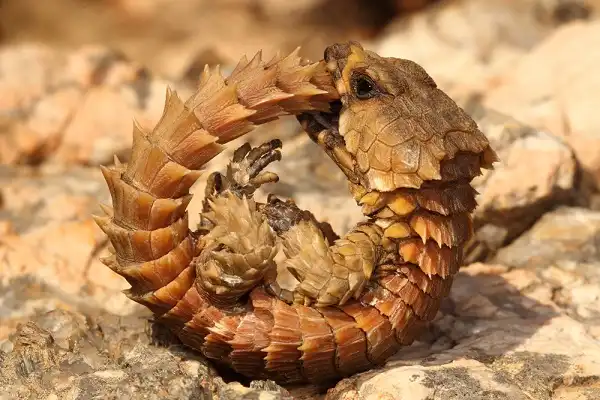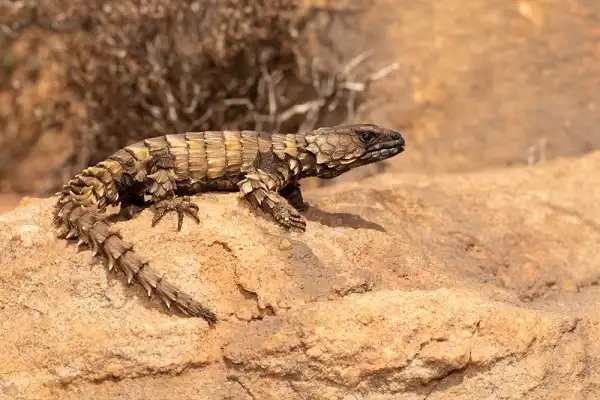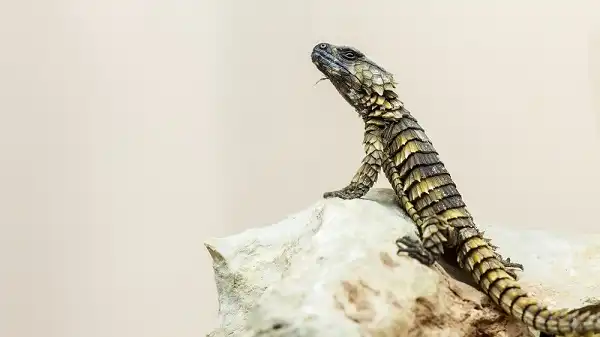Have you ever seen an armadillo lizard? With its peculiar armor-like shell and unique waddling gait, it’s one of the strangest creatures in the world. And due to its status being as a critically endangered species, few people have had the opportunity to experience this unusual creature up close. In this blog post, we’ll be discussing everything there is to know about armadillo lizards – from their fascinating behavior and diet habits, to how they’re able to survive in such harsh desert environments. So buckle up and get ready for a wild ride into the thrilling life of an armadillo lizard!

Armadillo Lizard Description
The Armadillo Lizard (Ouroborus cataphractus) is a distinctive creature, characterized by its unique armor-like exterior that closely resembles an armadillo’s shell. Its body is covered with large, rectangular, bony scales arranged in multiple rows, providing a formidable defense mechanism against predators. Its coloration ranges from light brown to dark, earthy tones, allowing it to blend seamlessly with its rocky desert surroundings. The tail, which is often curled over the lizard’s back when it feels threatened, is about twice the length of the body, acting as a vital tool for balance and navigation.
Armadillo Lizard Habitat
Armadillo Lizards are endemic to desert areas of South Africa, particularly the Succulent Karoo region. The Succulent Karoo is characterized by its arid conditions, sparse vegetation, and rocky terrain, which is conducive to the Armadillo Lizard’s survival. These lizards prefer rocky outcrops and crevices, where they dwell in groups. Their natural coloration provides excellent camouflage against the rugged desert landscape, affording them protection from predators. The Succulent Karoo’s unique biodiversity, particularly its rich invertebrate population, ensures a steady food supply for these lizards.
Despite the harshness of the desert environment, the Armadillo Lizard has adapted adeptly, utilizing crevices in rocks for shade during the intense midday heat and for hibernation during cooler months. The social structure within these dwelling groups is fascinating, with a dominant male typically overseeing a community of females and juveniles. Unfortunately, the Armadillo Lizard’s habitat is under threat due to human activity, such as overgrazing and mining, which disrupt the delicate balance of the Succulent Karoo ecosystem. This, coupled with the illegal pet trade, poses a significant challenge to the conservation of this unique species.
Armadillo Lizard Diet
Armadillo Lizards sustain themselves primarily on a diet of small invertebrates. Their powerful jaws and sharp teeth are perfectly adapted for consuming a variety of arthropods, including ants, spiders, and termites, which constitute the bulk of their diet. They display extraordinary hunting skills, stalking their prey with slow, deliberate movements before delivering a swift and fatal bite. Their long, sticky tongue also aids in capturing swift or elusive prey. In addition to invertebrates, these lizards are known to consume plant matter occasionally. During periods of scarcity, they have been observed eating soft leaves and tender shoots, indicating a level of dietary flexibility that further exemplifies their adaptability to their harsh, desert environment.

Armadillo Lizard Size
Armadillo Lizards are relatively small, but their size does not hinder their fascinating appeal. An adult Armadillo Lizard typically measures between 15.5 to 17 cm (6.1 to 6.7 inches) in total length, including the tail, which accounts for about two-thirds of its total length. Excluding the tail, its body length ranges from 6.5 to 9 cm (2.6 to 3.5 inches), making it a compact and sturdy creature. Despite its petite stature, the Armadillo Lizard’s body is robust and well-armored, a characteristic feature that gives it an appearance of grandeur and intimidation. Its broad, triangular head is proportionate to its stout body, giving the lizard a balanced and cohesive look. The size of the Armadillo Lizard varies slightly based on gender, with males usually being slightly larger than females. However, size isn’t the critical component for these lizards – it’s their unique ability to roll their bodies, making them seem bigger to predators and offering a protective advantage that outweighs mere physical dimensions.
Armadillo Lizard Lifespan
Armadillo Lizards, like many reptiles, have an impressive lifespan, given the harsh environments they inhabit. On average, these lizards can live up to 10 to 15 years in the wild. In captivity, where threats from predators and scarcity of food are eliminated, they have been known to live up to 20 years. This is contingent upon receiving appropriate care, including a balanced diet, sufficient exposure to ultraviolet light and an environment that mimics their natural habitat. The survival strategy of this species, which includes their armor-like exterior and social living arrangement, plays a significant role in their longevity. It allows them to withstand direct threats from predators as well as harsh environmental conditions. However, it’s crucial to note that many factors can impact an Armadillo Lizard’s lifespan. Threats such as habitat loss, human activities, and illegal pet trade can significantly shorten their lives. Therefore, conservation efforts to protect their habitat and regulate pet trade are vital for ensuring the longevity of this species. After all, the Armadillo Lizard is not just a unique organism but a symbol of the remarkable adaptations and survival strategies that nature has to offer.
Armadillo Lizard Behavior
Armadillo Lizards are known for their distinct and fascinating behaviors, which sets them apart from many other lizard species. One of the most notable behavioral traits is their unique defensive stance. When threatened by a predator, the Armadillo Lizard adopts a protective pose by rolling into a ball, similar to an armadillo. This behavior is possible due to their flexible vertebral column. They tuck their head inside the curl and grasp their tail in their mouth, presenting their tough, spiny scales to the predator. This defensive posture, coupled with their natural coloration, provides an effective deterrent against predators. Another interesting aspect of Armadillo Lizard’s behavior is their social structure. Unlike many other reptile species that lead solitary lives, Armadillo Lizards live in communal groups ranging from a few to up to 60 individuals.
These groups typically consist of a dominant male, several females, and juveniles. The dominant male often defends the shared territory from threats. The social structure within these groups is quite complex, with interactions ranging from communal basking and hunting to coordinated defensive behavior. They are even known to exhibit signs of distress when a member of their community is threatened, indicating a level of social bonding and empathy that is rare among reptiles. Armadillo Lizards also exhibit a diurnal activity pattern, meaning they are active during the day. Their activities include hunting, basking, and social interactions within their community.

Armadillo Lizard Speed
Given their small size and heavy body, Armadillo Lizards are not known for their speed. However, they exhibit an adequate level of agility and quickness when navigating their rocky habitats or escaping from predators. Their short, sturdy legs are adapted to their lifestyle, enabling them to swiftly scramble across rocks and into crevices when threatened. The Armadillo Lizard’s speed isn’t their primary defense, but it certainly plays a role in their survival strategies.
The speed of the Armadillo Lizard is somewhat dependent on the surrounding temperature. As ectothermic creatures, their body temperature and consequently, their physical activity levels are influenced by the environmental temperature. During cooler weather, their metabolism slows down, reducing their overall speed and agility. Conversely, in warmer temperatures, their metabolism increases, enhancing their speed and activity levels. Therefore, one can observe faster movements in Armadillo Lizards during the warmer parts of the day.
While speed is not the Armadillo Lizard’s most outstanding trait, their unique defensive posture makes them appear larger and more intimidating to potential predators, effectively deterring attacks. When threatened, they roll into a ball, tucking in their vulnerable parts and presenting their armored scales as a barrier. This behavior, combined with their capability to swiftly retreat into rock crevices, ensures their survival. So, while the Armadillo Lizard might not win any races, it is a champion when it comes to survival in the wild.
Armadillo Lizard Species
The Armadillo Lizard, known scientifically as Ouroborus cataphractus, belongs to the Cordylidae family. This species is native to the deserts of South Africa, where it thrives in rocky crevices and arid landscapes. The Armadillo Lizard is unique within its family due to its distinct physical characteristics and behaviors, which include its armor-like exterior and propensity for social living. Variations within the species are minimal, and as such, the Armadillo Lizard is not divided into subspecies. However, the Cordylidae family consists of many other interesting species. For example, the Sungazer (Smaug giganteus), also known as the Giant Girdled Lizard, shares a similar armored exterior but features a more prominent crest of spines along its back. Like the Armadillo Lizard, the Sungazer is a threatened species due to habitat loss and illegal pet trade.
Armadillo Lizard Reproduction
Armadillo Lizards exhibit an ovoviviparous mode of reproduction, a less common trait in reptiles. This means the female carries eggs within her body and gives birth to live offspring. The gestation period is estimated to range between 6 to 8 months, during which the female carries 1 to two eggs. This small number of offspring is attributed to the lizard’s armor-like body structure, which limits the number of eggs that can be carried at once. The mating season of Armadillo Lizards usually aligns with the warmer seasons when food is plentiful and temperatures are suitable for newborn lizards. The birthing process in Armadillo Lizards is highly intriguing. The eggs hatch within the mother, and she subsequently gives birth to live young. Upon birth, juvenile lizards are independent and possess all the basic survival skills necessary for immediate survival. They are miniature versions of the adults, equipped with the same defensive armor and skills. This instant independence is crucial for survival in their harsh environments, making the reproductive strategy of Armadillo Lizards remarkably efficient.

Armadillo Lizard Hunting
Armadillo Lizards, like many other reptiles, have a carnivorous diet that primarily consists of small invertebrates. They are skilled hunters, adept at seeking out and capturing a variety of prey, including insects, spiders, and snails. Their hunting strategy is essentially a wait-and-ambush method where they stay motionless, blending into their rocky environment, and strike swiftly when their prey comes within range. Their sharp eyesight aids in spotting potential meals, and their swift reflexes ensure successful catches. However, the hunting behavior of Armadillo Lizards extends beyond mere sustenance. These lizards also use hunting as a means of managing their internal body temperature. As ectotherms, their body temperature is influenced by environmental conditions. They strategically time their hunting activities to coincide with temperature peaks during the day, taking advantage of the warmth to boost their metabolism and hence, their hunting efficiency. Yet, hunting is not without its risks. While they are the predator of many smaller creatures, Armadillo Lizards are also prey to larger animals.
Conclusion
In conclusion, the Armadillo Lizard is an exceptional creature, showcasing a unique blend of physical adaptations, behavioral traits, and survival strategies that set it apart in the animal kingdom. From its remarkable defensive posture to its efficient reproductive method and strategic hunting techniques, every aspect of its lifestyle is perfectly in tune with its arid, rocky habitat. Despite the challenges posed by habitat loss and the illegal pet trade, this remarkable lizard continues to thrive in the harsh deserts of South Africa, a testament to its resilience and adaptability. Its story underscores the importance of ongoing conservation efforts to protect these fascinating reptiles and their habitats for future generations.
Frequently Asked Question


